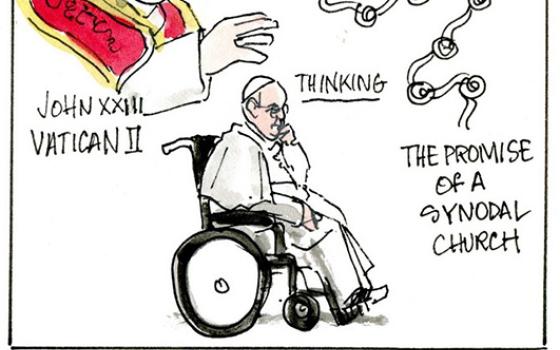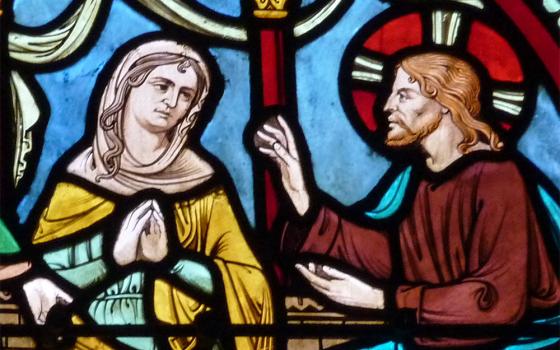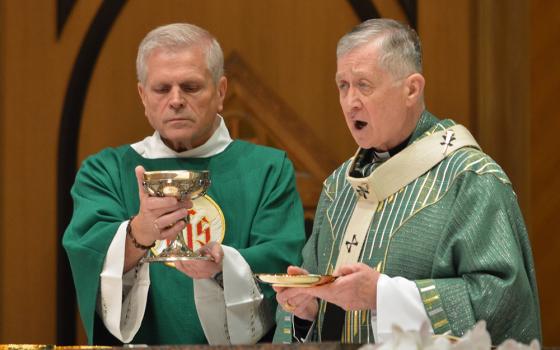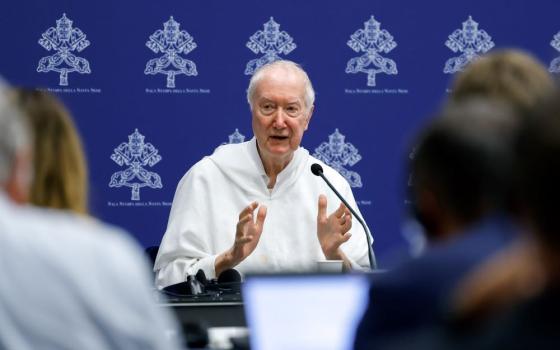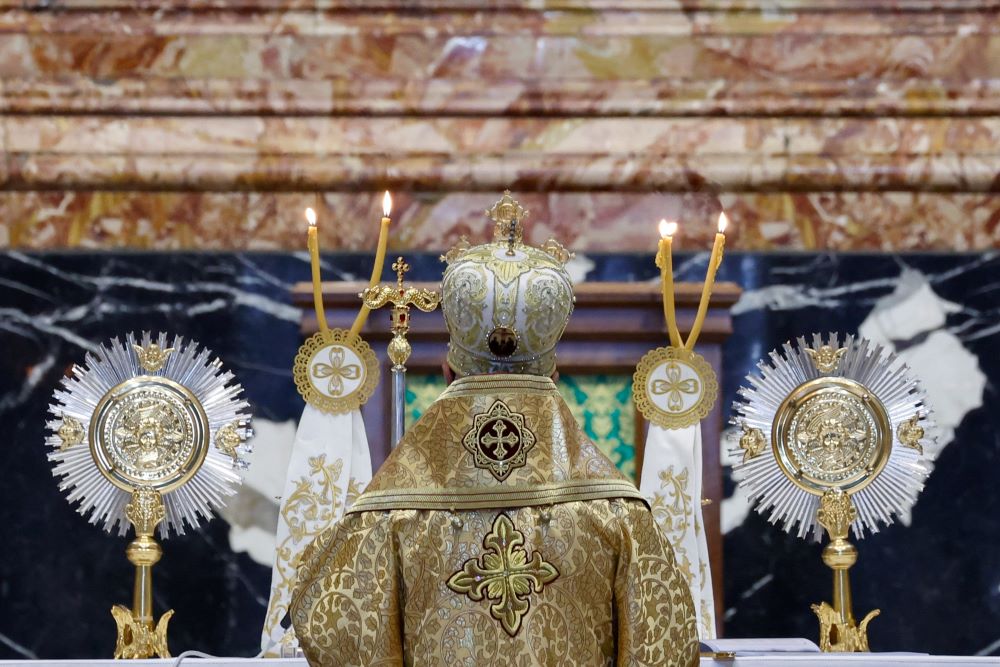
Melkite Catholic Patriarch Joseph Absi stands at the Altar of the Chair in St. Peter's Basilica for the celebration of a Byzantine Divine Liturgy as part of the assembly of the Synod of Bishops at the Vatican Oct. 9. (CNS/Lola Gomez)
This week's synod deliberations began with a Byzantine Divine Liturgy at St. Peter's Basilica. The short video of the service published by EWTN displayed some of the beauty of that liturgy, as well as its strangeness to Latin-rite Catholics. It is not at all like the Tridentine rite, nor is it like the post-Vatican II rite. The music is different. The vestments are different. The language is different.
The Byzantine Divine Liturgy recalled one of the dynamics at the Second Vatican Council. The traditionalists argued for a static and univocal understanding of the church, its theology and its liturgy. But the Patriarch of Antioch Maximos IV Saigh and other Byzantine prelates sometimes led the opening Masses that opened the council sessions. The patriarch also refused to address the assembly in Latin as the rules required, noting that the Greek language was more ancient in the Christian tradition. When it was pointed out to him that very few bishops understood Greek, he delivered all his interventions in French.
Focusing on the liturgy can clarify and enlighten all subsequent theological discussions.
One lesson of that episode, and of the Oct. 9 liturgy, is that a decisive argument for diversity lies in the historic diversity of the church. Diversity is not only something we seek; it is already here, and the question is how we cultivate it and balance it with the divine mandate that we all be one as well. In all the debates at Vatican II, anytime someone said there was only one way to do something, and that way could never change, they had to contend with the example of the exquisitely beautiful Byzantine liturgy they all had recently shared.
Another lesson from Vatican II is the way focusing on the liturgy can clarify and enlighten all subsequent theological discussions.
In the book What is Christian in Christianity?, a collection of essays and talks by the late, great Msgr. Lorenzo Albacete, makes the point. In the chapter drawn from a priest retreat Albacete delivered in 2008, we find this:
The Liturgy is the expression of the faith of the Church. … The Liturgy has immense power and authority, because it is the most authoritative gesture of the Church. Everything else, such as the Magisterium, exists to make the Liturgy and the Eucharist possible. We know that from the Council: "The Eucharist is the source and summit of the life of the Church." Everything in the Church is directed to it. So, we must follow the Liturgy of the Church. We must bring ourselves to the heart of the experience.
Watching those short videos of the Byzantine Divine Liturgy, I was reminded of these words of Albacete. I hope the synod delegates will listen to the liturgy and to what it tells us about the nature of our faith and the shape of our church. Among other things, the liturgy reminds us that grace often, even usually, works in ways that are unseen, something we pragmatic moderns are apt to forget.
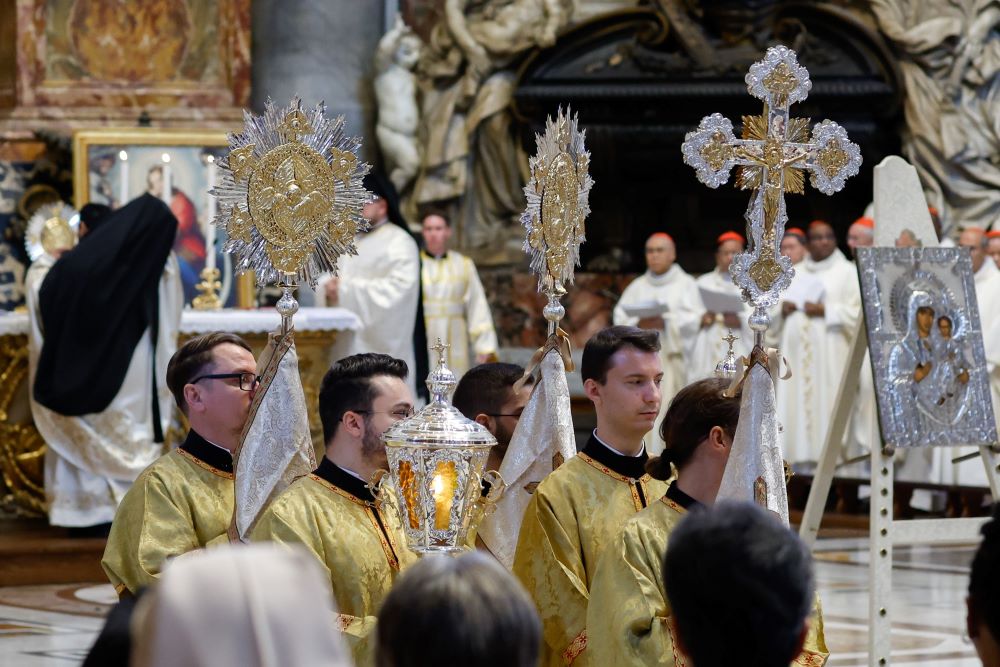
Servers lead the procession around the Altar of the Chair in St. Peter's Basilica during a Byzantine Divine Liturgy as part of the assembly of the Synod of Bishops at the Vatican Oct. 9. (CNS/Lola Gomez)
As luck or grace would have it, the opening talk at the session immediately following the Byzantine liturgy was delivered by Anna Rowlands, one of the synod organizers and a professor of Catholic social thought at Durham University in England. "Communion is the very power of this room ... in a modern world that tends towards both homogenizing things and fracturing things, communion is a language of beauty, a harmony of unity and plurality," she told the synod delegates.
Rowlands went on to recall a recent conversation with a survivor of clergy sex abuse:
He said, "Be bold about the need for healing. This is a paschal journey we must walk together. And tell them the Eucharist is life saving." Not all abuse survivors feel this way, but I share this because it has the character of a prophecy of communion; it calls for repentance, and proclaims the central truth of our faith.
Rowlands' recent book, Towards a Politics of Communion, which I reviewed here and here, demonstrates the ways an ecclesiology of Communion can be applied usefully and faithfully to the realm of politics. The book just won an "Expanded Reason" award from the Joseph Ratiznger-Benedict XVI Foundation.
N.B. In Europe, there seem to be many more left-of-center theologians who embrace Communion theology than in the U.S. It would be great if more U.S. theologians did so.
If the synod is to succeed, it needs to start its analysis always with this central truth of our faith: the redemptive suffering, death and resurrection of the Lord. The Mass allows us to enter into that great mystery of our faith, the redemptive passion and resurrection of the Lord, to join ourselves to it and, just so, to unite ourselves with Christians throughout the world and throughout the centuries.
Advertisement
It is at Mass that the eternal breaks into the world. It is at Mass that we are reminded of the church's most essential powers: suffering, prayer, healing and hope. The Mass turns the world upside down because Christ's death and resurrection turns the world upside down. God's power is seen in the very vulnerability of his son. Agendas and plans and programs do not fall by the wayside. We are called to act. Before we act, however, we Christians receive and we can only act as Christians insofar as we have received the grace that comes to us through the ages from Calvary.
In the first volume of his trilogy on Jesus of Nazareth, Pope Benedict XVI wrote:
The great question that will be with us throughout this entire book: What did Jesus actually bring if not world peace, universal prosperity, and a better world? What has he brought? The answer is very simple: God. He has brought God. He has brought the God who formerly unveiled his countenance gradually, first to Abraham, then to Moses and the Prophets, and then in the Wisdom Literature — the God who revealed his face only in Israel, even though he was honored among the pagans in various shadowy guises.… Jesus has brought God and with God the truth about our origin and destiny: faith, hope and love.
The synod is reflecting on the various ways millions of Catholics, each with different and similar experiences, have discussed how God is active in their lives, how we have failed to live up to the great vocation given us, how faith, hope and love have transformed and continue to transform their lives. The synod is called to consider how the church, in this moment of time, can continue to proclaim the presence of God that Jesus has brought us and which he continues to bring us, at Mass and in our acts of charity. For the life of me, I can't see why anyone is scared of such an endeavor.





